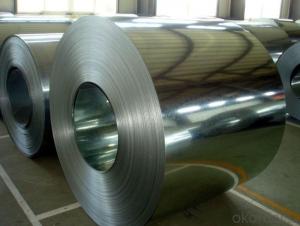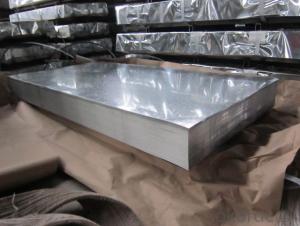Color Coated Steel Sheet In Coils Hot Sell
- Loading Port:
- Tianjin
- Payment Terms:
- TT OR LC
- Min Order Qty:
- 25 m.t.
- Supply Capability:
- 1000 m.t./month
OKorder Service Pledge
OKorder Financial Service
You Might Also Like
1.Structure of Color Coated Steel Sheet in Coils Hot Sell:
With Gi as base metal,after pretreatmet (degrease and chemical treatment) and liquid dope with several Layers of color,then after firing and cooling,finally the plate steel is called pre-painted galvanized steel ( PPGI) .Pre-painted galvanized steel is good capable of decoration ,molding,corrosion resistance
2.Main Features of Color Coated Steel Sheet in Coils Hot Sell:
• Excellent process capability
• Smooth and flat surface
• Workability, durability
• Excellent heat resistance performance
• High strength
• Good formability
• Good visual effect
3.Color Coated Steel Sheet in Coils Hot Sell Images

4.Color Coated Steel Sheet in Coils Hot Sell Specification
Standard:ASTM, GB,JIS,JIS G3302 ASTM 755 EN10169
Grade: DX51D CGCC CS
Thickness: 0.13mm~3.0mm,
Width: 1250,600-1250mm
Coil weight:3-12 MT
Coil ID:508/610mm
Chemical composition:
C | Si | Mn | Cr | Ni | P | S |
0.150 | 0.476 | 11.231 | 12.50 | 0.900 | 0.039 | 0.010
|
5.FAQ of Color Coated Steel Sheet in Coils Hot Sell
We have organized several common questions for our clients,may help you sincerely:
1.How do you control your quality
We have established the international advanced quality management system,every link from raw material to final product we have strict quality test;We resolutely put an end to unqualified products flowing into the market. At the same time, we will provide necessary follow-up service assurance.
2.How long we will receive the goods ?
After receiving your deposit or workable lc ,our normal shipment date is 15-20days,and it takes around 28 days to reach your port of destination. But is up to different destination
3. What is your MOQ?
Normally our MOQ is 25mt per size ,but it is up to different size.
- Q: What kind of material does ordinary steel plate refer to in steel market?
- Wear resistance and special electromagnetic properties, carbon steel in this respect is relatively poor, because in the manufacture of this kind of steel plate, often to maintain good toughness, so we reduced the iron element to join. Not as a result of the steel sheet in abrasion resistance and special electromagnetic aspects is very weak, but the alloy plate is different because adding other alloying elements, which makes the original in iron deficiency situation has been greatly improved this is better for some special requirements of customers.
- Q: What is the average price of a steel sheet?
- The average price of a steel sheet can vary depending on several factors such as the size, thickness, quality, and market conditions. Generally, steel sheets can range in price from $500 to $1500 per ton. However, it is important to note that prices can fluctuate due to factors such as global demand, production costs, and trade policies. Additionally, different suppliers may offer different prices, so it is advisable to compare prices from multiple sources before making a purchase.
- Q: Are steel sheets suitable for industrial machinery components?
- Yes, steel sheets are suitable for industrial machinery components due to their high strength, durability, and ability to withstand heavy loads and extreme conditions commonly found in industrial settings. Steel sheets also offer excellent machinability, allowing for precise shaping and customization of components as per specific requirements. Additionally, steel sheets can be easily welded, offering flexibility in design and assembly processes.
- Q: Can steel sheets be used for flooring?
- No, steel sheets are not typically used for flooring as they are not suitable for walking on due to their slippery surface and lack of insulation.
- Q: Are steel sheets suitable for electrical grounding applications?
- Indeed, electrical grounding applications can find steel sheets to be fitting. As a proficient conductor of electricity, steel can proficiently transmit electrical charges to the ground. Due to their endurance, robustness, and cost-efficiency, steel sheets are frequently employed in grounding applications. Their installation is simple, and they offer a trustworthy link to the earth, guaranteeing a secure pathway for electrical currents in the event of a fault or surge. Nevertheless, it is imperative to ensure the proper installation and upkeep of steel sheets, as any corrosion or harm can impede their conductivity and hinder their efficacy in grounding electrical systems.
- Q: Can steel sheets be used for railway track components?
- Yes, steel sheets can be used for railway track components. Steel is a commonly used material in railway construction due to its strength, durability, and resistance to wear and tear. Steel sheets can be fabricated and shaped into various railway track components such as rails, sleepers, and fasteners, ensuring the stability and longevity of the track system.
- Q: What is the typical yield strength of a steel sheet?
- The typical yield strength of a steel sheet can vary depending on the specific grade and thickness of the sheet. However, on average, the yield strength of a steel sheet is typically between 250 and 400 megapascals (MPa).
- Q: Can steel sheets be used for railway applications?
- Yes, steel sheets can be used for railway applications. Steel sheets are commonly used in the construction of railway tracks, bridges, and other infrastructure due to their high strength, durability, and resistance to wear and tear. They can be formed into various shapes and sizes to meet the specific requirements of railway applications. Additionally, steel sheets can be easily welded, which allows for efficient and cost-effective installation and repair of railway components. Overall, steel sheets are a popular choice in the railway industry due to their excellent mechanical properties and ability to withstand heavy loads and harsh environmental conditions.
- Q: How do you prevent galvanic corrosion when using steel sheets with other metals?
- One way to prevent galvanic corrosion when using steel sheets with other metals is by applying a protective coating or barrier between the metals. This can be done through methods such as painting, powder coating, or using a corrosion-resistant primer. Additionally, using non-conductive materials or insulating the metals from direct contact can also help prevent galvanic corrosion. Regular maintenance and inspection to identify any signs of corrosion early on is also important in preventing its progression.
- Q: Can steel sheets be welded?
- Yes, steel sheets can be welded. Welding involves using heat to melt the edges of the steel sheets and then joining them together to form a strong and permanent bond.
Send your message to us
Color Coated Steel Sheet In Coils Hot Sell
- Loading Port:
- Tianjin
- Payment Terms:
- TT OR LC
- Min Order Qty:
- 25 m.t.
- Supply Capability:
- 1000 m.t./month
OKorder Service Pledge
OKorder Financial Service
Similar products
Hot products
Hot Searches
Related keywords




























